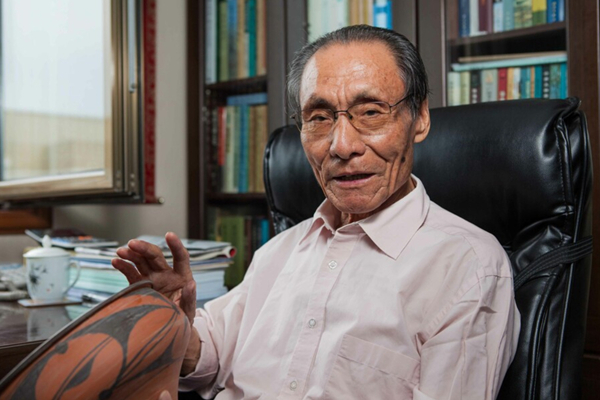


Yan Wenming: Founder of Chinese Neolithic archaeology system

Yan Wenming Photo: Zhang Zhe/CSST
On April 14, 2024, Yan Wenming, a renowned Chinese archaeologist, passed away at the age of 92. Yan was a pioneering figure in the field of Neolithic archaeology in China and a key architect of the Chinese Neolithic archaeology system. He made groundbreaking contributions in numerous domains, including the cultural sequence of prehistoric China, the evolution of prehistoric settlement patterns, the origins of Chinese agriculture and civilization, and the study of ancient legends.
The ‘Multi-Petal Flower’ Theory
In 1958, after graduating from Peking University and joining its faculty, Yan began teaching undergraduate courses on Neolithic archaeology. At that time, the archaeology department at Peking University was newly established and was short on textbooks. Consequently, Yan drafted the initial teaching materials for a course on “Neolithic Archaeology,” which were later formalized into a textbook in 1964. This work became the first textbook on Neolithic archaeology in China and had a profound impact on the field. Compiling these notes required the extensive collection, analysis, and synthesis of data from across the country, as well as a global perspective on China’s Neolithic age. This comprehensive effort provided Yan with a broad academic vision from the very outset of his career.
In 1987, Yan published Unity and Diversity in Chinese Prehistoric Culture, in which he not only proposed a framework for the cultural sequence of prehistoric China but also explained the geographical and environmental contexts of this sequence. More importantly, he visualized the cultural landscape of Neolithic China as a multi-petal flower, where the entire flower symbolized the unity or wholeness of prehistoric Chinese culture, while the individual petals represented the diversity of surrounding regional cultures, with the central core representing the culture of the Central Plains [This metaphor illustrates how different regional cultures were interconnected yet distinct, contributing to the overall cultural and civilizational development of ancient China]. Yan believed that this “multi-petal flower” pattern directly influenced the development of Chinese civilization, laying the foundation for a unified multi-ethnic modern China.
China’s vast territory and diverse geographical environments have resulted in a complex archaeological cultural landscape, making the establishment of a Neolithic archaeological cultural sequence a gradual and intricate process that must start with the analysis of materials from various regions. Yan’s research began with the Yangshao culture, for which he became renowned as a leading expert. For his book Research on Yangshao Culture, he undertook comprehensive studies on the chronology, regional types, developmental stages, settlement patterns, burial practices, and symbolic painted pottery of the Yangshao culture. Su Bingqi praised the book as a key to unlocking the entire field of Chinese Neolithic archaeological research. This key lies in Yan’s research methodology, which involved first dating the sites typical of the Yangshao culture, then exploring regional differences and classifying them into different types, and finally examining the settlement patterns and social conditions of the sites. Starting in the 1950s and 60s, Yan successively dated typical sites such as Wangwan, Yangshao, Banpo, Miaodigou, Sanliqiao, Xiyincun, and Beishouling, culminating in his seminal paper “A Brief Discussion on the Origins and Developmental Stages of Yangshao Culture.” Additionally, his work Origins and Development of Gansu Painted Pottery vividly outlined the gradual east-to-west expansion of painted pottery culture, refuting the claims that Yangshao culture was introduced from the west. Moreover, his concept of the “Longshan Era” significantly advanced Longshan archaeological research. His view that a Chalcolithic Age once existed in China, similar to that in the western Eurasian continent, is increasingly supported by archaeological findings.
Origins of Chinese agriculture
Settlement archaeology is a crucial method for studying the evolution of civilizations, and Yan was a pioneering advocate for this approach in China. In 1981, Yan, alongside Gong Qiming, analyzed the layout of the moat-surrounded village at Jiangzhai site, the practice of which became a model for Chinese settlement archaeology. His analysis of the Hengzhen cemetery established a new paradigm for the spatial analysis of prehistoric Chinese cemeteries. His extensive research also covered Yangshao houses and settlement patterns, Banpo-type burial and social systems, the evolution of China’s moat-surrounded settlements, the transformation of Neolithic settlements, and the city sites of the Longshan Era.
The origins of agriculture are another primary topic in Neolithic archaeology. In the 1980s, based on archaeological findings, Yan was the first to propose the “Yangtze River as Point of Origins” for rice civilization. The origin of agriculture is the prerequisite for the origin of civilization, and has been a key subject of archaeological research since V. Gordon Childe. However, as of the early 1980s, the origins of agriculture in China, the largest agricultural region in the ancient world, were still vague. Was China an important origin area for rice agriculture? If so, was it in south China, the Yunnan-Guizhou Plateau, or the Yangtze River basin? In the 1980s, drawing on archaeological discoveries at sites like Hemudu and Pengtoushan, as well as analysis of the distribution of rice cultivation sites, ancient rice varieties, and the lifestyles of early agricultural communities, Yan first proposed that the Yangtze River basin was the major center for the development of rice agriculture. He argued that while regions such as south China, Southeast Asia, and India were rich in plant resources, there was less impetus to develop local agriculture. In contrast, the Yangtze River basin, though home to wild rice, was located on the periphery of its distribution. Yan argued that climatic fluctuations leading to food shortages likely spurred the initial development of rice cultivation. His hypothesis about the origins of rice agriculture has been increasingly supported by archaeological evidence and has garnered widespread attention from both Chinese and international academic circles. Yan also organized and led research projects at the Xianrendong-Diaotonghuan sites and Yuchanyan site, the findings of which push the origins of agriculture in the Yangtze River basin back to over 10,000 years ago.
Han Jianye is a professor from the School of History at Renmin University of China.
Copyright©2023 CSSN All Rights Reserved